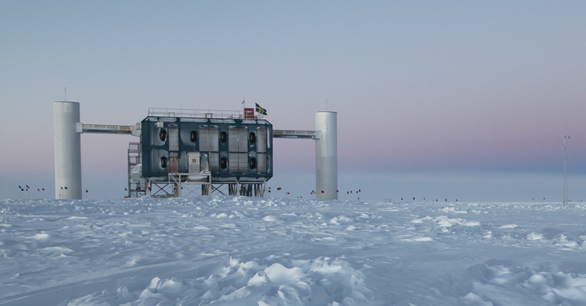IceCube
The IceCube Neutrino Observatory is a particle detector at the South Pole that records the interactions of a nearly massless subatomic particle called the neutrino. IceCube searches for neutrinos from the most violent astrophysical sources: events like exploding stars, gamma-ray bursts, and cataclysmic phenomena involving black holes and neutron stars.
Learn More Visit WebsiteARA
The Askaryan Radio Array (ARA) is a radio detector array operating at the South Pole, designed for the detection of ultra-high-energy cosmic neutrinos using the emission of radio pulses produced by interactions in the Antarctic ice. This instrument is an R&D device geared toward an IceCube-Gen2 radio detector. The goal is to detect the cosmogenic neutrino flux at energies above 1017 eV.
Learn More Visit WebsiteHAWC
The High-Altitude Water Cherenkov, or HAWC, experiment is a TeV-energy-scale gamma-rayobservatory located at high altitude in Mexico. Its primary goal is to survey the Northern Hemisphere sky for steady and transient high-energy gamma rays and thereby determine the sources of Galactic cosmic rays. The instrument’s construction was completed in January 2015.
Learn More Visit WebsiteDM-Ice
DM-Ice, or Dark Matter-Ice, is searching for dark matter in the Southern Hemisphere. The goal is to perform a search for dark matter using the time variation resulting from the motion of the detector relative to the dark matter halo as a signature. If confirmed, the observation would revolutionize our understanding of particle physics and cosmology. A prototype detector is currently deployed at the South Pole and a next-generation engineering detector array, part of the Cosine-100 experiment, is currently running deep underground in Korea.
Learn More Visit WebsiteCTAO
The Cherenkov Telescope Array Observatory (CTAO) will use dozens of imaging atmospheric Cherenkov telescopes to detect gamma rays between 30 GeV and 100 TeV in energy. A prototype telescope is under construction, the first Schwarzschild-Couder telescope ever built, on Mount Hopkins in Arizona. The main goals of CTAO are to understand the nature of dark matter and of extreme objects in the universe, including huge black holes at the center of distant galaxies and the remnants of exploded stars, which are possible sources of cosmic rays.
Learn More Visit WebsiteRNO-G
The Radio Neutrino Observatory in Greenland (RNO-G) is under construction at the Summit Station in Greenland to search for ultra-high-energy neutrinos. Each of the 35 stations to be deployed will have a surface component and a deep component (100 meters below the surface of the ice) that together enable the detection and detailed reconstruction of neutrino events.
Learn More Visit Website





